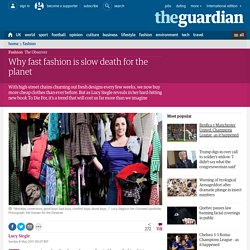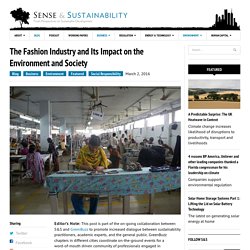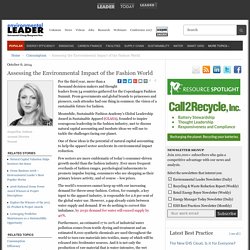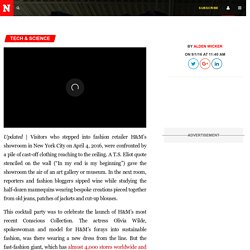

Why fast fashion is slow death for the planet. Every morning when I wake up I am confronted by my fashion history.

Mistakes, corrections, good buys, bad buys, comfort buys, drunk buys: they refuse to go away. This is because my wardrobe is opposite my bed, and the door, like a broken zipper, will no longer pull across to hide the tale of excess. In the cold light of day many of the micro trends I've "invested in" – T-shirts with chains, a one-shouldered jumpsuit, and other designer lookalike items – merge to form a type of sartorial wasteland. My collection is testament to the extraordinary way we now consume clothes.
And I don't have to come around to your house and have a look to make a good guess at what you've got in your cupboards, because over the past decade and a half not only have we bought more at increasing speed, but our tastes have become increasingly homogenised. You now demand roughly four times the number of clothes you would have in 1980. Zara's policy was a game-changer. So how does Big Fashion keep costs so low? The Fashion Industry and Its Impact on the Environment and Society. Editor’s Note: This post is part of the on-going collaboration between S&S and GreenBuzz to promote increased dialogue between sustainability practitioners, academic experts, and the general public.

GreenBuzz chapters in different cities coordinate on-the-ground events for a word-of-mouth driven community of professionals engaged in sustainability, bringing sustainability leaders together to connect with each other and to discuss specific sustainability topics. S&S will publish excerpts, summaries, and discussions generated by these events in order to facilitate on-going debate and make the information presented at these events available to a world-wide audience. When we think of climate change, certain sectors, such as agriculture and transportation, are most commonly considered key in addressing climate change posed challenges.
Assessing the Environmental Impact of the Fashion World. For the third year, more than a thousand decision makers and thought leaders from 34 countries gathered for the Copenhagen Fashion Summit.

From governments and global brands to princesses and pioneers, each attendee had one thing in common: the vision of a sustainable future for fashion. Meanwhile, Sustainable Fashion Academy’s Global Leadership Award in Sustainable Apparel (GLASA), founded to inspire courageous leadership in the fashion industry, met to discuss natural capital accounting and incubate ideas we will use to tackle the challenges facing our planet. One of these ideas is the potential of natural capital accounting to help the apparel sector accelerate its environmental impact reduction.
Few sectors are more emblematic of today’s consumer-driven growth model than the fashion industry. Ever more frequent overhauls of fashion ranges, psychological inducements to promote impulse buying, consumers who see shopping as their primary leisure activity, and of course – low prices. Fast Fashion Is Creating an Environmental Crisis. Updated | Visitors who stepped into fashion retailer H&M’s showroom in New York City on April 4, 2016, were confronted by a pile of cast-off clothing reaching to the ceiling.

A T.S. Eliot quote stenciled on the wall (“In my end is my beginning”) gave the showroom the air of an art gallery or museum. In the next room, reporters and fashion bloggers sipped wine while studying the half-dozen mannequins wearing bespoke creations pieced together from old jeans, patches of jackets and cut-up blouses. This cocktail party was to celebrate the launch of H&M’s most recent Conscious Collection. Fast fashion, "value" fashion. Fast fashion, "value" fashion ‘We now buy 40% of all our clothes at value retailers, with just 17% of our clothing budget.’

TNS Worldpanel (2006) Fashion Focus issue 29 A Cambridge University study reports that in 2006, people were buying a third more clothes than they were in 2002, and women have four times as many clothes in their wardrobe than they did in 1980. Women are also getting rid of similar amounts each year. Brands began competing against each other for market share by introducing more lines per year at lower costs, culminating in a situation where ‘fashion houses now offer up to 18 collections a year’ and the low cost, so called ‘value end’ is ‘booming; doubling in size in just 5 years Retailers must respond to quickly changing fashion trends, which now change in weeks instead of months – thanks in part to instant coverage of fashion weeks and street style online.
This naturally has led to pressure on the supply chain. A bit more context…. This had several benefits. 26 22221 ()